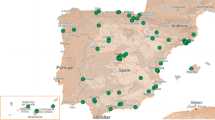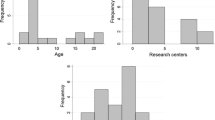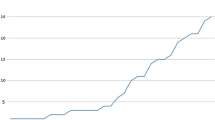Abstract
We study the successfulness of Science Parks (SPs) as seedbeds of innovation. We investigate whether SPs enhance the innovative output of their tenants and if tenants outperform comparable outside-SPs firms. We rely on original matching datasets regarding in- and out-SP Finnish firms and their patenting activity over 1970–2002. We estimate and compare the ‘before-versus-after’ hazard rates of patenting of both samples. The results suggest that, given the existence of a common tendency to slow down the pace at which all firms patent during their life cycle, Park tenants exhibit a comparatively better performance. Results are robust to various model specifications and to Wald tests performed over the pooled samples.






Similar content being viewed by others
Notes
See Sect. 2 for a review of the literature
Innovation has also been one of the priorities of the Finnish Presidency of the Council of the European Union (II semester 2006, www.eu2006.fi).
A regional perspective is also guiding Kang’s (2004) analysis of the Korean experience, which aims to establish development models for SPs depending upon the framework conditions under which the Parks are supposed to be built.
According to the IASP official definition “A Science Park is an organization managed by specialized professionals, whose main aim is to increase the wealth of its community by promoting the culture of innovation and the competitiveness of its associated businesses and knowledge-based institutions. To enable these goals to be met, a Science Park stimulates and manages the flow of knowledge and technology amongst universities, R&D institutions, companies and markets; it facilitates the creation and growth of innovation-based companies through incubation and spin-off processes; and provides other value-added services together with high quality space and facilities.” (IASP International Board, 6 February 2002). The fact that the Parks considered in the study are either members of Tekel or IASP or both makes them easily distinguishable from business parks and similar initiatives, thus eliminating a possible source of heterogeneity.
No information could be obtained about the remaining three Science Parks.
Sheehan (2001) finds response rates to oscillate between 21.6% and 36% and Jobber and Saunders (1993) indicate that the rate of response in business-oriented studies is more sensitive than consumers’ ones to characteristics as the number of questions, the length of the survey, etc.
The type of companies we refer to are Nokia, Sonera, Orion and the like.
These samples look very tiny indeed but one should bear in mind that patenting in Finland is not a ‘massive’ phenomenon. The NBPR has in fact dealt with 2200–2900 patent files per year over the period the 1998–2002. Furthermore, the number of patents applications at the Finnish level has steadily decreased during the last decade, often in favour of EPO, PCT, etc. applications.
The strength of Cox’s approach—where the hazard is of the form λ (t; x) = κ(x) λ 0 (t), κ (·) > 0 is a nonnegative function of x and λ 0 (t) > 0 is the baseline hazard—is that the effect of the covariates can be estimated very generally, without having to specify the baseline hazard.
All the tables, in their full versions, are available from the author, upon request.
Wald tests are chi-square statistics, pure significance tests against the null hypothesis that a parameter is zero, i.e., that the corresponding variable has no effect given that the other variables are in the model (Greene 2000)
Table 1A, in Appendix, shows the result of the Wald tests obtained while holding the number of observations constant.
References
Acs, Z. J., & Audretsch, D. B. (1991). Firm size and innovative activity. In Z. J. Acs, D. B. Audretsch (Eds.), Innovation and technological change. Harvester Wheatsheaf.
Acs, Z. J., & Audretsch, D. B. (1988). Innovation in large and small firms: An empirical analysis. American Economic Review , 678 – 690.
Acs, Z. J., & Audretsch, D. B. (1990). Innovation and small firms, MIT Press, Cambridge.
Aghion, P., & Tirole, J. (1994). The management of innovation. The Quarterly Journal of Economics,109, 1185–1209.
Appold, S. J. (2004). Research Parks and the location of industrial research laboratories: An analysis of the effectiveness of a policy intervention. Research Policy, 33, 225–243.
Audretsch, D. B., & Feldman, M. P. (1996). R&D spillovers and the geography of innovation and production. American Economic Review, 86(3), 630 – 640.
Borgan, Ø., & Langholz, B. (2005). Using martingale residuals to assess goodness-of-fit for sampled risk set data. Statistical Research Report, Dept. of Math., University of Oslo, n. 8.
Box-Steffensmeier, J. M., & Zorn, C. (2002). Duration models for repeated events. The Journal of Politics, 1069–1094.
Cameron, A. C., & Trivedi, P. K. (2005). Microeconometrics. Cambridge University Press.
Cassiman, B., & Veugelers, R. (2002). R&D cooperation and spillovers: Some empirical evidence from Belgium. American Economic Review, 92(4), 1169–1184.
Cefis, E. (2003). Is there persistence in innovative activities? International Journal of Industrial Organization, 21, 489–515.
Chakrabarti, A. K. (1990). Scientific output of small and medium size firms in high tech industries. IEEE Transactions on Engineering Management, 37(1), 48–52.
Cleves, M. A., Gould, W. W., & Gutierrez, R. G. (2002). An introduction to survival analysis using stata. USA: Stata Corporation.
Cohen, W. M., Levin, R. C., & Mowery, D. C. (1987). Firm size and R&D intensity: A re-examination. Journal of Industrial Economics, 543 – 565.
Colombo, M., & Delmastro, M. (2002). How effective are technology incubators? Evidence from Italy. Research Policy, 31, 1103–1122.
Crépon, B., Duguet, E., & Mairesse, J. (1998). Research, innovation, and productivity: an econometric analysis at the firm level, NBER Working Papers n. 6696.
Evans D. S. (1987). Tests of alternative theories of firm growth. The Journal of Political Economy, 95 (4), 657–674.
Feldman, M. P., & Audretsch D. B. (1999). Innovation in cities: Science-based diversity, specialization and localized competition. European Economic Review, 43, 409–429.
Felsenstein D., (1994). University-related science parks: “seedbeds” or “enclaves” of innovation? Technovation, 14, 93–110.
Ferguson, R., & Olofsson C. (2004) Science parks and the development of NTBFs - location, survival and growth. Journal of Technology Transfer, 29, 5–17.
Fukugawa, N. (2006). Science parks in Japan and their value-added contributions to new technology- based Firms. International Journal of Industrial Organization 24, 381– 400.
Geroski, P. A., Van Reenen, J., & Walters, C. F. (1997). How persistently do firms innovate? Research Policy, 26(1), 33 – 48.
Greene, W. H. (2000). Econometric analysis (IV ed.). Prentice Hall International.
Griliches Z., (1990). Patent statistics as economic indicators: A survey. Journal of Economic Literature, 28 (4), 1661–1707.
Grossman, G., & Helpman, E. (1990). Trade, innovation and growth. American Economic Review, 80 (2), 86–91.
Hall, B. H. (1987). The relationship between firm size and firm growth in the US manufacturing sector. The Journal of Industrial Economics, 35 (4), 583–606.
Heckman, J., Ichimura, H., & Todd, P. E. (1997). Matching as an econometric evaluation estimator: Evidence from evaluating a job training programme. The Review of Economic Studies, 64(4), 605–654.
Heckman, J., Ichimura, H., & Todd, P. (1998). Matching as an econometric evaluation estimator. The Review of Economic Studies, 65(2), 261–294.
Heckman, J., Ichimura, H., Smith, J. A., & Todd, P. (1998). Characterizing selection bias using experimental data. Econometrica, 66(5), 1017–1098.
Heckman, J., & Navarro-Lozano, S. (2004). Using matching, instrumental variables, and control functions to estimate economic choice models. The Review of Economics and Statistics, 86(1), 30–57.
Heckman, J., & Smith, J. A. (1999). The pre-programme earning dip and the determinants of participation in a social programme. Implications for simple programme evaluation strategies. The Economic Journal, 109 (457), 313–348.
Heckman J., & Vytlacil, E. J. (2001) Local instrumental variables. In C. Hsiao, K. Morimune, & J. L. Powell (Eds.), Nonlinear statistical modeling: Proceedings of the Thirteen International Symposium in Economic Theory and Econometrics: Essays in Honor of Takeshi Amemiya(pp. 1–46). Cambridge, UK: Cambridge University Press.
Henderson, V., Kuncoro, A., & Turner, M., (1995). Industrial development in cities. Journal of Political Economy, 103, 1067–1090.
Hosmer, D. W. Jr, & Lemeshow, S. (1999). Applied survival analysis. Regression modeling of time to event data. New York: J. Wiley & Sons Inc.
Ichimura, H., & Taber, C. (2001). Propensity-score matching with instrumental variables. American Economic Review, 91(2), 119–124.
International Association of Science Parks, www.iasp.ws
Hodgson, B. (1996). A methodological framework to analyse the impact of Science and Technology Parks. In M. Guedes, & P. Formica (Eds.), The Economics of Science Parks. IASP and AURRP.
Jaffe, A. B., & Trajtenberg, M. (2002). Patents, citations and innovations. Cambridge (MA): The MIT Press.
Jobber, D., & Saunders, J. (1993). A note on the applicability of the Brurold-Comer model for mail survey response rates to commercial populations. Journal of Business Research, 223–236.
Jovanovic, B. (1982). Selection and the evolution of industry. Econometrica, 649–670.
Kang, B.-J. (2004). A study of the establishing development model for Research Parks. Journal of Technology Transfer, 29, 203–210.
Katz M. L., (1986). An analysis of cooperative research and development. RAND Journal of Economics, 17, 527–543.
Kelly, P. J., & Lim, L. L.-Y. (2000). Survival analysis for recurrent event data: An application to child infectious diseases. Statistics in Medicine, 19, 13–33.
Klein, J. P., & Moeschberger, M. L. (1997). Survival analysis. Techniques for censored and truncated data. New York: Springer-Verlag.
Klette, T. J. (1996). R&D, scope economies, and plant performance. RAND Journal of Economics, 27(3), 502–522.
Klette, T. J., & Grliches, Z. (2000). Empirical patterns of firm growth and R&D investment: A quality ladder model interpretation. The Economic Journal, 110, 363– 387.
Lancaster, T. (1990). The econometric analysis of transition data. Cambridge: Cambridge University Press.
Lin, D. Y., & Wei, L. J. (1989). The robust inference for the Cox proportional hazards model. Journal of the American Statistical Association, 84, 1074–1078.
Link, A. N., & Scott, J. T. (2003). US science parks: The diffusion of an innovation and its effects on the academic missions of universities. International Journal of Industrial Organization, 21, 1323–1356.
Link, A. N., & Scott, J. T. (2006). US university research parks. Journal of Productivity Analysis, 25, 43–55.
Lindelöf, P., & Löfsten, H. (2003). Science parks location and new technology-based firms in Sweden—implications for strategy and performance. Small Business Economics, 20, 245–258.
Lindelöf, P., &, Löfsten, H. (2004). Proximity as a resource base for competitive advantage: University-industry links for technology transfer. Journal of Technology Transfer 29, 311–326.
Löfsten, H., & Lindelöf, P. (2001). Science parks in Sweden: Industrial renewal and development? R&D Management 31, 309–322.
Löfsten, H., & Lindelöf, P. (2002). Science parks and the growth of new technology-based firms—academic-industry links, innovation and markets. Research Policy, 31, 859–876.
Löfsten, H.,& Lindelöf,P. (2005). R&D networks and product innovation patterns—academic and non- academic new technology-based firms on science parks, Technovation, 25, 1025– 1037.
Luger, M. I., & Goldstein, H. A. (1991). Technology in the garden, Chapel Hill, UNC Press.
Massey, D., Quintas, P., & Wield, D. (1992). High-tech fantasies. Science parks in society, science and space. London: Routledge.
Monck, C. S. P., Porter, R. B., Quintas, P., Storey, D. J., & Wynarczyk, P. (1988). Science parks and the growth of high technology firms. Peat Marwick McLintock.
Organisation for Economic Co-operation and Development (OECD). (1997). Technology incubators: Nurturing young firms, OCDE/GD (97) 202.
Pavitt, K., Robson, M., & Townsend, J. (1987). The size distribution of innovating firms in the UK: 1945–1983. The Journal of Industrial Economics, 35(3), 373–379.
Prentice, R. L., Williams, B. J., & Peterson, A. V. (1981). On the regression analysis of multivariate failure time data. Biometrika, 68, 373–379.
Sasieni, P. D., & Winnett, A. (2003). Martingale difference residuals as a diagnostic tool for the Cox model. Biometrika, 899–912.
Scherer F. M., (1980) Industrial market structure and economic performance. Rand Mc Nally.
Scherer, F. M. (1984). Using linked patent and R&D data to measure interindustry technology flows. In Z. Griliches (Ed.), R&D, patents and productivity. Chicago: Chicago University Press.
Sena, V. (2004). The return of the Prince of Denmark: a survey on recent developments in the economics of innovation. The Economic Journal, 114, 312–332.
Shane, S. (2001). Technological opportunities and new firm creation. Management Science, 47(2), 205–220.
Sheehan, K. (2001). E-mail survey response rates: A review. Journal of Computer-Mediated Communication.
Siegel, D. S., Westhead, P., & Wright, M. (2003). Assessing the impact of University Science parks on research productivity: Exploratory firm-level evidence from the United Kingdom. International Journal of Industrial Organization, 21, 1357–1369.
Smith, P. E., & Todd, J. A. (2005). Does matching overcome LaLonde’s critique of nonexperimental estimators? Journal of Econometrics, 125 , 305–353.
Squicciarini, M. (2005b). Do Science parks encourage innovation? Evidence from the tenants’ patenting activity—a duration model, working paper presented at the 4th International Industrial Organization Conference, Boston.
Squicciarini, M. (2005a). Science parks’ characteristics and companies’ innovative performance: Evidence from Finland, working paper presented at the 7th Conference on “Innovations and Intellectual Property”, Applied Econometrics Association, Paris.
Stein J. C. (1997). Waves of creative destruction: Firm-specific learning-by-doing and the dynamics of innovation. The Review of Economic Studies, 64(2), 265 – 288.
Struthers, C. A., & Kalbfleish, J. D. (1984). Misspecified proportional hazard models. Biometrica, 73, 363–369.
Therneau, T. M., & Grambsch, P. M. (2000). Modeling survival data: Extending the Cox model. New York: Springer.
Van den Berg, G. J. (2001). Duration models: Specification, identification and multiple durations in handbook of econometrics, (Vol. 5). Elsevier Science.
Wei, L. J., Lin, D. Y., & Weissfeld, L. (1989). Regression analysis of multivariate incomplete failure time data by modeling marginal distributions. Journal of the American Statistical Association, 84, 1065–1073.
Westhead, P. (1997). R&D ‘inputs’ and ‘outputs’ of technology-based firms located on and off Science parks. R&D Management, 27(1), 45–62.
Westhead, P., & Storey, D. J. (1994). An assessment of firms located on and off Science parks in the United Kingdom. UK: SME Centre, University of Warwick.
Acknowledgements
I am particularly indebted to Pierre Regibeau, Steve Pudney, David Audretsch, Marco Francesconi, Gabriella Conti and Otto Toivanen. Thanks also go to Zoltan Acs, Mariana Mazzucato and the participants in various seminars and conferences, especially the EARIE 2006, for helpful comments. The usual disclaimers apply.
Author information
Authors and Affiliations
Corresponding author
Appendix
Appendix
Rights and permissions
About this article
Cite this article
Squicciarini, M. Science Parks’ tenants versus out-of-Park firms: who innovates more? A duration model. J Technol Transfer 33, 45–71 (2008). https://doi.org/10.1007/s10961-007-9037-z
Received:
Accepted:
Published:
Issue Date:
DOI: https://doi.org/10.1007/s10961-007-9037-z




